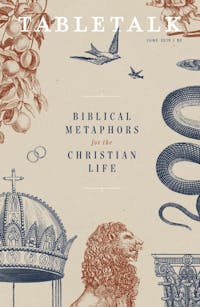
Request your free, three-month trial to Tabletalk magazine. You’ll receive the print issue monthly and gain immediate digital access to decades of archives. This trial is risk-free. No credit card required.
Try Tabletalk NowAlready receive Tabletalk magazine every month?
Verify your email address to gain unlimited access.
Dr. Steven J. Lawson once compared the Bible to a diamond whose beauty, when it is held up to the light, is refracted in many different ways:
No one symbol of the Bible can communicate the whole. So, it requires many different metaphors, many different analogies, to even begin to try to [understand] the totality of the invincible power of the inerrant Word.
The Bible is full of images, symbols, and metaphors that God uses to help us know Him and relate to Him—and to help us know ourselves. He uses metaphors to help us understand truths about this present life and about eternal life and eternal condemnation.
While we can likely think of certain well-known metaphors in Scripture, such as those of shepherd and sheep, vine and branches, and others, we must recognize that the Bible uses many different metaphors, similes, symbols, and images, some of which may sound strange to our ears, particularly if we are from the West. Remember, the Bible is steeped in the culture of the Levant. Depending on where we are from and what experiences we have had, many of these metaphors may be difficult for us to relate to. Yet, in His wisdom, God uses them to help His people from around the world, from many different contexts, to know Him more. The metaphors of Scripture reveal to us Scripture’s own comprehensive beauty—but more than that, they reveal the beauty of our gracious God who relates to us, condescends to us, and speaks to us in words we can understand.
If pressed beyond their limits, of course, metaphors lose their didactic quality. We must be careful not to read too much into metaphors, overuse them, or unnecessarily limit entire doctrinal concepts to metaphors. Nevertheless, the metaphors, symbols, and images of Scripture help us associate our experiences in life with spiritual and doctrinal concepts so that we can know God more and serve Him more fully. Studying them can help us see more and more rays of beauty proceeding from the beautiful diamond that is Scripture. Much of that beauty is a great comfort to our souls. God calls Himself our Father and comforts us by calling us His children. He has revealed Himself to us in ways that help us relate to Him as our loving, gracious, and holy Father and in ways that help us have a humble, dependent, and childlike faith. As we grow in our maturity as His children, His Holy Spirit helps us know Him more and more deeply as our Shepherd, our Rock, and our Fortress as we follow Christ Jesus who is the way, the truth, and the life.
